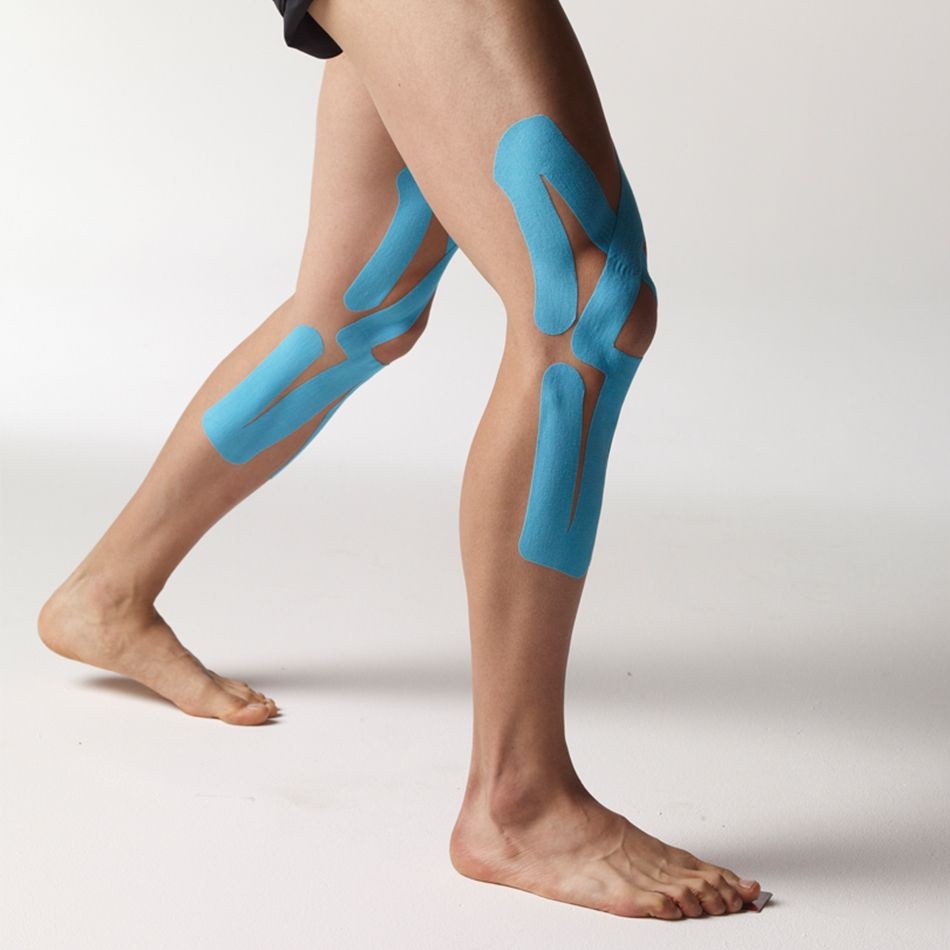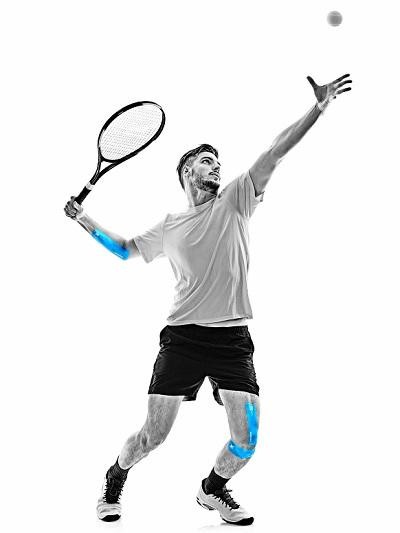If you have seen any behind the scene’s footage of a professional football or basketball team, you may have noticed a few of the athletes walking around the locker room with colorful strips of tape on their backs, shoulders, or knees. That tape is called kinesiology tape and is used by many amateur and professional athletes after their game to promote the healing of an injured joint or body part. It is also common for athletes to use kinesiology tape on their knees during the game for support and to increase their range of motion.
It may seem far-fetched, but kinesiology tape is effective in healing injuries and supporting joints that experience high-impact movements.
How Kinesiology Tape Supports the Knee
High-quality kinesiology tape is extremely sticky, stretchy, and flexible; all of which are important factors to ensure the tape stays in place and helps support the body part it is applied to. An example of high-quality kinesiology tape for knee support is Spider Tech’s x-spider Tape. This tape is designed to emulate your skin’s natural elasticity, and when it’s placed on your knee, you regain your full range of motion so you can properly perform as you play your sport. This tape is always drug-free, easy-to-use, waterproof and lasts up to five days, even after it gets wet.
Helps create space in joints
When kinesiology tape is applied to a body part, it lifts your skin to create space between your skin and the tissues underneath, allowing for more blood flow to the injured area. When it is applied to your knee, the tape will increase the space in your knee joint. This helps support your knee and reduces the chance that the joint becomes irritated.
Improves blood circulation
Kinesiology tape also aids in blood circulation. If you have injured your knee or another part of your body, applying kinesiology tape can improve blood circulation and reduce the swelling to help with pain relief. To go along with that, kinesiology tape can also help improve the circulation of lymphatic fluids, which is water with protein and bacteria to help control swelling and fluid build-up.
Diverts pain signals
In recent years, physical therapists have used kinesiology tape to “trick” the brain into thinking there is no pain in your injured area. All the tissues in your body have sensory receptors that allow you to feel temperature and pain. When kinesiology is applied to a tense or knotted muscle, it lifts the tissues and the pain receptors will send a new signal to the brain to change the pathway of your pain.
Why You Should Apply Kinesiology Tape To Your Knee
There are many benefits you can receive when you apply kinesiology tape to your knee, including:
Treat your injuries
If you have injured your knee, the best way to treat it is to combine kinesiology tape and physical therapy to help reduce swelling and pain for quick recovery time.
Perform better
If your knee isn’t 100% healthy, you can apply kinesiology tape to loosen it up, protect against further injury, and provide a full range of motion. Runners, volleyball players, hockey players, and tennis players commonly use kinesiology tape on their knees to “awaken” the muscles to help them enhance their performance.
Strengthen weak zones
Kinesiology tape is often used to help regain movement in your knee if there are any weak or fatigued joints and muscles in or around the area.
Improving the appearance of scars
Kinesiology tape has been used to manage the appearance of scars, although you should first consult with a doctor to ensure it is safe to place the tape close or on the scar. We will get into this later in the article, but you should never put kinesiology tape on an open wound.
Is Kinesiology Tape Actually Effective?
The short answer to this question is yes, it is effective in many aspects, including supporting knees and reducing inflammation in other injured parts of the body. However, to get the most out of kinesiology tape, it is best to use it with other forms of treatment like physical therapy.
When Should You Not Use Kinesiology Tape?
Before applying kinesiology tape for the first time, you should consult with your doctor as there are a few circumstances where you should not use kinesiology tape. Here are some examples:
- Allergies: Some people may be allergic or sensitive to the adhesive on kinesiology tape.
- Open wounds: If you use kinesiology tape on an open wound, it could cause skin damage or an infection.
- Weak skin: If you have fragile skin in certain areas, you should avoid applying kinesiology tape as it may tear the skin.
- Cancer: Since kinesiology tape promotes blood flow, taping near a cancerous growth and providing it more blood could be dangerous.
- Deep vein thrombosis: Blood clots may dislodge after an increase in blood flow, which can be dangerous.
Applying Kinesiology Tape:
If this is your first time using kinesiology tape, you should consult your physical therapist on the proper application techniques for the best results.
There are four common patterns that you will use when you apply kinesiology tape, which include a Y, I, X, or fan. The pattern that you apply will depend on the type of injury and the recovery process. Make sure you practice each technique with your physical therapist to ensure you are always applying the tape correctly.
When you are comfortable applying the tape yourself, here are the steps you need to take to get your skin ready and the application process.
- Make sure you wash and dry the skin where you will be applying the tape. Do not put on any lotion as it can prevent the tape from sticking.
- Shave or trim thick hair as it could prevent the tape from sticking properly.
- Take the tape and peel the paper on the back from the middle.
- Gently apply the first corner and let it recoil. Be careful not to stretch the tape too much as it can pull your skin and cause irritation.
- After the tape is applied, rub it for a few seconds because heat will activate the glue. Make sure you don’t move the area too vigorously as the tape can take about 20 minutes to settle.
Use Spider Tech For The Best Results
If you are experiencing knee pain due to an injury, Spider Tech offers full knee pre-cut kinesiology tape to help you recover quicker. The tape was designed so you can continue your training or workouts during the rehabilitation period.
Author’s Bio
Colin Hearty is a content writer for BreezeMaxWeb that helps businesses showcase their brand through enticing copy. When he’s not working, you can find him playing net in a local beer league or biking around the city.



